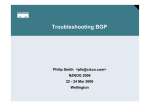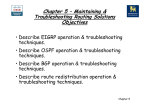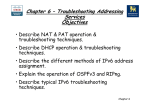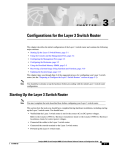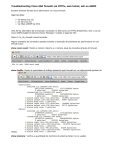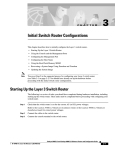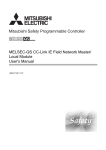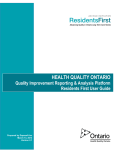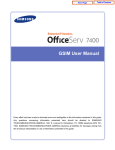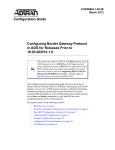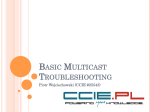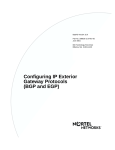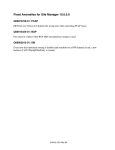Download BGP Tutorial Part 4 – Troubleshooting
Transcript
BGP Tutorial Part 4 – Troubleshooting Philip Smith <[email protected]> APRICOT 2003, Taipei February 2003 APRICOT2003 © 2003, Cisco Systems, Inc. All rights reserved. 1 Presentation Slides • Slides are available at ftp://ftp-eng.cisco.com/pfs/seminars/APRICOT02-BGP03.pdf • Feel free to ask questions any time APRICOT2003 © 2003, Cisco Systems, Inc. All rights reserved. 2 Assumptions • Presentation assumes working knowledge of BGP Beginner and Intermediate experience of protocol • Knowledge of Cisco CLI Hopefully you can translate concepts into your own router CLI • If in any doubt, please ask! APRICOT2003 © 2003, Cisco Systems, Inc. All rights reserved. 3 Fundamentals of Troubleshooting • Before we begin/Troubleshooting is about: Not panicking Creating a checklist Working to that checklist Starting at the bottom and working up • This presentation will have references throughout to checklists They are the best way to work to a solution They are what many NOC staff follow when diagnosing and solving network problems APRICOT2003 © 2003, Cisco Systems, Inc. All rights reserved. 4 Agenda • Peer Establishment • Missing Routes • Inconsistent Route Selection • Loops and Convergence Issues • Internet Reachability Problems APRICOT2003 © 2003, Cisco Systems, Inc. All rights reserved. 5 Peer Establishment • Routers establish a TCP session Port 179—Permit in ACLs IP connectivity (route from IGP) • OPEN messages are exchanged Peering addresses must match the TCP session Local AS configuration parameters APRICOT2003 © 2003, Cisco Systems, Inc. All rights reserved. 6 Common Problems • Sessions are not established No IP reachability Incorrect configuration • Peers are flapping Layer 2 problems APRICOT2003 © 2003, Cisco Systems, Inc. All rights reserved. 7 Peer Establishment—Diagram 1.1.1.1 ? 2.2.2.2 iBGP R1 R2 eBGP 3.3.3.3 AS 1 R3 ? AS 2 R2#sh run | begin ^router bgp router bgp 1 bgp log-neighbor-changes neighbor 1.1.1.1 remote-as 1 neighbor 3.3.3.3 remote-as 2 APRICOT2003 © 2003, Cisco Systems, Inc. All rights reserved. 8 Peer Establishment—Symptoms R2#show ip bgp summary BGP router identifier 2.2.2.2, local AS number 1 BGP table version is 1, main routing table version 1 Neighbor V AS MsgRcvd MsgSent TblVer InQ OutQ Up/Down State 1.1.1.1 4 1 0 0 0 0 0 never Active 3.3.3.3 4 2 0 0 0 0 0 never Idle • Both peers are having problems State may change between Active, Idle and Connect APRICOT2003 © 2003, Cisco Systems, Inc. All rights reserved. 9 Peer Establishment • Is the Local AS configured correctly? • Is the remote-as assigned correctly? • Verify with your diagram or other documentation! Local AS R2# router bgp 1 neighbor 1.1.1.1 remote-as 1 neighbor 3.3.3.3 remote-as 2 APRICOT2003 © 2003, Cisco Systems, Inc. All rights reserved. iBGP Peer eBGP Peer 10 Peer Establishment—iBGP • Assume that IP connectivity has been checked • Check TCP to find out what connections we are accepting R2#show tcp brief all TCB Local Address 005F2934 *.179 0063F3D4 *.179 Foreign Address 3.3.3.3.* 1.1.1.1.* (state) LISTEN LISTEN We Are Listening for TCP Connections for Port 179 for the Configured Peering Addresses Only! R2#debug ip tcp transactions TCP special event debugging is on R2# TCP: sending RST, seq 0, ack 2500483296 TCP: sent RST to 4.4.4.4:26385 from 2.2.2.2:179 Remote Is Trying to Open the Session from 4.4.4.4 Address… APRICOT2003 © 2003, Cisco Systems, Inc. All rights reserved. 11 Peer Establishment—iBGP What about Us? R2#debug ip bgp BGP debugging is on R2# BGP: 1.1.1.1 open active, local address 4.4.4.5 BGP: 1.1.1.1 open failed: Connection refused by remote host We Are Trying to Open the Session from 4.4.4.5 Address… R2#sh ip route 1.1.1.1 Routing entry for 1.1.1.1/32 Known via "static", distance 1, metric 0 (connected) * directly connected, via Serial1 Route metric is 0, traffic share count is 1 R2#show ip interface brief | include Serial1 Serial1 4.4.4.5 YES manual up APRICOT2003 © 2003, Cisco Systems, Inc. All rights reserved. up 12 Peer Establishment—iBGP • Source address is the outgoing interface towards the destination but peering in this case is using loopback interfaces! • Force both routers to source from the correct interface • Use “update-source” to specify the loopback when loopback peering R2# router bgp 1 neighbor 1.1.1.1 remote-as 1 neighbor 1.1.1.1 update-source Loopback0 neighbor 3.3.3.3 remote-as 2 neighbor 3.3.3.3 update-source Loopback0 APRICOT2003 © 2003, Cisco Systems, Inc. All rights reserved. 13 Peer Establishment—Diagram 1.1.1.1 2.2.2.2 iBGP R1 R2 eBGP 3.3.3.3 AS 1 R3 ? AS 2 • R1 is established now • The eBGP session is still having trouble! APRICOT2003 © 2003, Cisco Systems, Inc. All rights reserved. 14 Peer Establishment—eBGP • Trying to load-balance over multiple links to the eBGP peer • Verify IP connectivity Check the routing table Use ping/trace to verify two way reachability R2#ping 3.3.3.3 Type escape sequence to abort. Sending 5, 100-byte ICMP Echos to 3.3.3.3, timeout is 2 seconds: !!!!! Success rate is 100 percent (5/5), round-trip min/avg/max = 4/4/8 ms • Routing towards destination correct, but… APRICOT2003 © 2003, Cisco Systems, Inc. All rights reserved. 15 Peer Establishment—eBGP R2#ping ip Target IP address: 3.3.3.3 Extended commands [n]: y Source address or interface: 2.2.2.2 Type escape sequence to abort. Sending 5, 100-byte ICMP Echos to 3.3.3.3, timeout is 2 seconds: ..... Success rate is 0 percent (0/5) • Use extended pings to test loopback to loopback connectivity • R3 does not have a route to our loopback, 2.2.2.2 APRICOT2003 © 2003, Cisco Systems, Inc. All rights reserved. 16 Peer Establishment—eBGP • Assume R3 added a route to 2.2.2.2 • Still having problems… R2#sh ip bgp neigh 3.3.3.3 BGP neighbor is 3.3.3.3, remote AS 2, external link BGP version 4, remote router ID 0.0.0.0 BGP state = Idle Last read 00:00:04, hold time is 180, keepalive interval is 60 seconds Received 0 messages, 0 notifications, 0 in queue Sent 0 messages, 0 notifications, 0 in queue Route refresh request: received 0, sent 0 Default minimum time between advertisement runs is 30 seconds For address family: IPv4 Unicast BGP table version 1, neighbor version 0 Index 2, Offset 0, Mask 0x4 0 accepted prefixes consume 0 bytes Prefix advertised 0, suppressed 0, withdrawn 0 Connections established 0; dropped 0 Last reset never External BGP neighbor not directly connected. No active TCP connection APRICOT2003 © 2003, Cisco Systems, Inc. All rights reserved. 17 Peer Establishment—eBGP R2# router bgp 1 neighbor 3.3.3.3 remote-as 2 neighbor 3.3.3.3 ebgp-multihop 2 neighbor 3.3.3.3 update-source Loopback0 • eBGP peers are normally directly connected By default, TTL is set to 1 for eBGP peers If not directly connected, specify ebgp-multihop • At this point, the session should come up APRICOT2003 © 2003, Cisco Systems, Inc. All rights reserved. 18 Peer Establishment—eBGP R2#show ip bgp summary BGP router identifier 2.2.2.2, local AS number 1 Neighbor 3.3.3.3 V 4 AS MsgRcvd MsgSent 2 10 26 TblVer 0 InQ OutQ Up/Down 0 0 never State/PfxRcd Active • Still having trouble! Connectivity issues have already been checked and corrected APRICOT2003 © 2003, Cisco Systems, Inc. All rights reserved. 19 Peer Establishment—eBGP R2#debug ip bgp events 14:06:37: BGP: 3.3.3.3 open active, local address 2.2.2.2 14:06:37: BGP: 3.3.3.3 went from Active to OpenSent 14:06:37: BGP: 3.3.3.3 sending OPEN, version 4 14:06:37: BGP: 3.3.3.3 received NOTIFICATION 2/2 (peer in wrong AS) 2 bytes 0001 14:06:37: BGP: 3.3.3.3 remote close, state CLOSEWAIT 14:06:37: BGP: service reset requests 14:06:37: BGP: 3.3.3.3 went from OpenSent to Idle 14:06:37: BGP: 3.3.3.3 closing • If an error is detected, a notification is sent and the session is closed • R3 is configured incorrectly Has “neighbor 2.2.2.2 remote-as 10” Should have “neighbor 2.2.2.2 remote-as 1” • After R3 makes this correction the session should come up APRICOT2003 © 2003, Cisco Systems, Inc. All rights reserved. 20 eBGP summary • Remember to allow TCP/179 through filters Common eBGP implementation error access-list 100 permit tcp host 3.3.3.3 eq 179 host 2.2.2.2 access-list 100 permit tcp host 3.3.3.3 host 2.2.2.2 eq 179 • Need to be careful with ebgp-multihop Peer between loopback interfaces Needed to loadshare Remember update-source loopback 0 TTL must be at least 2 for ebgp-multihop between directly connected neighbours Use TTL value carefully APRICOT2003 © 2003, Cisco Systems, Inc. All rights reserved. 21 Peer Establishment—Passwords • Using passwords on iBGP and eBGP sessions Link won’t come up Been through all the previous troubleshooting steps R2#show ip bgp summary BGP router identifier 2.2.2.2, local AS number 1 Neighbor 3.3.3.3 APRICOT2003 V 4 AS MsgRcvd MsgSent 2 10 26 © 2003, Cisco Systems, Inc. All rights reserved. TblVer 0 InQ OutQ Up/Down 0 0 never State/PfxRcd Active 22 Peer Establishment—Passwords R2# router bgp 1 neighbor 3.3.3.3 neighbor 3.3.3.3 neighbor 3.3.3.3 neighbor 3.3.3.3 remote-as 2 ebgp-multihop 2 update-source Loopback0 password 7 05080F1C221C • Configuration on R2 looks fine! • Check the log messages – enable “log-neighbor-changes” %TCP-6-BADAUTH: No MD5 digest from 3.3.3.3:179 to 2.2.2.2:11272 %TCP-6-BADAUTH: No MD5 digest from 3.3.3.3:179 to 2.2.2.2:11272 %TCP-6-BADAUTH: No MD5 digest from 3.3.3.3:179 to 2.2.2.2:11272 APRICOT2003 © 2003, Cisco Systems, Inc. All rights reserved. 23 Peer Establishment—Passwords R3# router bgp 2 neighbor 2.2.2.2 remote-as 1 neighbor 2.2.2.2 ebgp-multihop 2 neighbor 2.2.2.2 update-source Loopback0 • Check configuration on R3 Password is missing from the eBGP configuration • Fix the R3 configuration Peering should now come up! But it does not APRICOT2003 © 2003, Cisco Systems, Inc. All rights reserved. 24 Peer Establishment—Passwords • Let’s look at the log messages again for any clues R2# %TCP-6-BADAUTH: Invalid MD5 digest from 3.3.3.3:11024 to 2.2.2.2:179 %TCP-6-BADAUTH: Invalid MD5 digest from 3.3.3.3:11024 to 2.2.2.2:179 %TCP-6-BADAUTH: Invalid MD5 digest from 3.3.3.3:11024 to 2.2.2.2:179 • We are getting invalid MD5 digest messages – password mismatch! APRICOT2003 © 2003, Cisco Systems, Inc. All rights reserved. 25 Peer Establishment—Passwords • We must have typo’ed the password on one of the peering routers Fix the password – best to re-enter password on both routers eBGP session now comes up %TCP-6-BADAUTH: Invalid MD5 digest from 3.3.3.3:11027 to 2.2.2.2:179 %BGP-5-ADJCHANGE: neighbor 3.3.3.3 Up APRICOT2003 © 2003, Cisco Systems, Inc. All rights reserved. 26 Flapping Peer—Diagram AS 1 AS 2 eBGP R1 R2 Layer 2 ATM or FR Cloud • Symptoms – the eBGP session flaps • eBGP peering establishes, then drops, re-establishes, then drops,… APRICOT2003 © 2003, Cisco Systems, Inc. All rights reserved. 27 Flapping Peer • Enable “bgp log-neighbor-changes” so you get a log message when a peer flaps • R1 and R2 are peering over ATM cloud R2# %BGP-5-ADJCHANGE: neighbor 1.1.1.1 Down BGP Notification sent %BGP-3-NOTIFICATION: sent to neighbor 1.1.1.1 4/0 (hold time expired) 0 bytes R2#show ip bgp neighbor 1.1.1.1 | include Last reset Last reset 00:01:02, due to BGP Notification sent, hold time expired • We are not receiving keepalives from the other side! APRICOT2003 © 2003, Cisco Systems, Inc. All rights reserved. 28 Flapping Peer • Let’s take a look at our peer! R1#show ip bgp sum BGP router identifier 172.16.175.53, local AS number 1 BGP table version is 10167, main routing table version 10167 10166 network entries and 10166 paths using 1352078 bytes of memory 1 BGP path attribute entries using 60 bytes of memory 0 BGP route-map cache entries using 0 bytes of memory 0 BGP filter-list cache entries using 0 bytes of memory BGP activity 10166/300 prefixes, 10166/0 paths, scan interval 15 secs Neighbor 2.2.2.2 V 4 AS MsgRcvd MsgSent TblVer InQ OutQ Up/Down State/PfxRcd 2 53 284 10167 0 97 00:02:15 0 R1#show ip bgp summary | begin Neighbor Neighbor V AS MsgRcvd MsgSent TblVer InQ OutQ Up/Down State/PfxRcd 2.2.2.2 4 2 53 284 10167 0 98 00:03:04 0 • Hellos are stuck in OutQ behind update packets! • Notice that the MsgSent counter has not moved APRICOT2003 © 2003, Cisco Systems, Inc. All rights reserved. 29 Flapping Peer R1#ping 2.2.2.2 Type escape sequence to abort. Sending 5, 100-byte ICMP Echos to 2.2.2.2, timeout is 2 seconds: !!!!! Success rate is 100 percent (5/5), round-trip min/avg/max = 16/21/24 m R1#ping ip Target IP address: 2.2.2.2 Repeat count [5]: Datagram size [100]: 1500 Timeout in seconds [2]: Extended commands [n]: Sweep range of sizes [n]: Type escape sequence to abort. Sending 5, 1500-byte ICMP Echos to 2.2.2.2, timeout is 2 seconds: ..... Success rate is 0 percent (0/5) • Normal pings work but a ping of 1500 fails? APRICOT2003 © 2003, Cisco Systems, Inc. All rights reserved. 30 Flapping Peer—Diagram AS 1 AS 2 eBGP R1 R2 Layer 2 ATM or FR Cloud Small Packets Large Packets • Small packets are ok • Large packets are lost in the cloud • BGP session flaps APRICOT2003 © 2003, Cisco Systems, Inc. All rights reserved. 31 Flapping Peer • Things to check MTU values Traffic shaping Rate-limiting parameters • Looks like a Layer 2 problem • At this point we have verified that BGP is not at fault • Next step is to troubleshoot layer 2… APRICOT2003 © 2003, Cisco Systems, Inc. All rights reserved. 32 Flapping Peer—Diagram AS 1 AS 2 eBGP R1 R2 Layer 2 Small Packets ATM or FR Cloud Large Packets • Large packets are ok now • BGP session is stable! APRICOT2003 © 2003, Cisco Systems, Inc. All rights reserved. 33 Troubleshooting Tips • Extended ping/traceroute allow you to verify Loopback to loopback IP connectivity TTL issues • “show ip bgp summary” Displays the state of all peers • “show ip bgp neighbor” Gives a lot of information regarding the peer APRICOT2003 © 2003, Cisco Systems, Inc. All rights reserved. 34 Troubleshooting Tips • “debug ip bgp” Should give you a good hint as to why a peer will not establish • “debug ip bgp events” Displays state transitions for peers • “show ip bgp neighbor | include Last reset” Will show you the last reset reason for all peers APRICOT2003 © 2003, Cisco Systems, Inc. All rights reserved. 35 Agenda • Peer Establishment • Missing Routes • Inconsistent Route Selection • Loops and Convergence Issues • Internet Reachability Problems APRICOT2003 © 2003, Cisco Systems, Inc. All rights reserved. 36 Quick Review • Once the session has been established, UPDATEs are exchanged All the locally known routes Only the bestpath is advertised • Incremental UPDATE messages are exchanged afterwards APRICOT2003 © 2003, Cisco Systems, Inc. All rights reserved. 37 Quick Review • Bestpath received from eBGP peer Advertise to all peers • Bestpath received from iBGP peer Advertise only to eBGP peers A full iBGP mesh must exist APRICOT2003 © 2003, Cisco Systems, Inc. All rights reserved. 38 Missing Routes—Agenda • Route Origination • UPDATE Exchange • Filtering • iBGP mesh problems APRICOT2003 © 2003, Cisco Systems, Inc. All rights reserved. 39 Route Origination—Example I • Network statement R1# show run | include 200.200.0.0 network 200.200.0.0 mask 255.255.252.0 • BGP is not originating the route??? R1# show ip bgp | include 200.200.0.0 R1# • Do we have the exact route? R1# show ip route 200.200.0.0 255.255.252.0 % Network not in table APRICOT2003 © 2003, Cisco Systems, Inc. All rights reserved. 40 Route Origination—Example I • Nail down routes you want to originate ip route 200.200.0.0 255.255.252.0 Null0 254 • Check the RIB R1# show ip route 200.200.0.0 255.255.252.0 200.200.0.0/22 is subnetted, 1 subnets S 200.200.0.0 [1/0] via Null 0 • BGP originates the route!! R1# show ip bgp | include 200.200.0.0 *> 200.200.0.0/22 APRICOT2003 © 2003, Cisco Systems, Inc. All rights reserved. 0.0.0.0 0 32768 41 Route Origination—Example II • Trying to originate an aggregate route aggregate-address 7.7.0.0 255.255.0.0 summary-only • The RIB has a component but BGP does not create the aggregate??? R1# show ip route 7.7.0.0 255.255.0.0 longer 7.0.0.0/32 is subnetted, 1 subnets C 7.7.7.7 [1/0] is directly connected, Loopback 0 R1# show ip bgp | i 7.7.0.0 R1# APRICOT2003 © 2003, Cisco Systems, Inc. All rights reserved. 42 Route Origination—Example II • Remember, to have a BGP aggregate you need a BGP component, not a RIB (Routing Information Base, a.k.a. the routing table) component R1# show ip bgp 7.7.0.0 255.255.0.0 longer R1# • Once BGP has a component route we originate the aggregate network 7.7.7.7 mask 255.255.255.255 R1# show ip bgp 7.7.0.0 255.255.0.0 longer *> 7.7.0.0/16 0.0.0.0 s> 7.7.7.7/32 0.0.0.0 32768 i 0 32768 i • s means this component is suppressed due to the “summary-only” argument APRICOT2003 © 2003, Cisco Systems, Inc. All rights reserved. 43 Troubleshooting Tips • BGP Network statement rules Always need an exact route (RIB) • aggregate-address looks in the BGP table, not the RIB • “show ip route x.x.x.x y.y.y.y longer” Great for finding RIB component routes • “show ip bgp x.x.x.x y.y.y.y longer” Great for finding BGP component routes APRICOT2003 © 2003, Cisco Systems, Inc. All rights reserved. 44 Missing Routes • Route Origination • UPDATE Exchange • Filtering • iBGP mesh problems APRICOT2003 © 2003, Cisco Systems, Inc. All rights reserved. 45 Missing Routes—Example I • Two RR clusters • R1 is a RR for R3 • R2 is a RR for R4 • R4 is advertising 7.0.0.0/8 R1 R2 R3 R4 • R2 has the route but R1 and R3 do not? APRICOT2003 © 2003, Cisco Systems, Inc. All rights reserved. 46 Missing Routes—Example I • First, did R2 advertise the route to R1? R2# show ip bgp neighbors 1.1.1.1 advertised-routes BGP table version is 2, local router ID is 2.2.2.2 Network *>i7.0.0.0 Next Hop 4.4.4.4 Metric LocPrf Weight Path 0 100 0I • Did R1 receive it? R1# show ip bgp neighbors 2.2.2.2 routes Total number of prefixes 0 APRICOT2003 © 2003, Cisco Systems, Inc. All rights reserved. 47 Missing Routes—Example I • Time to debug!! access-list 100 permit ip host 7.0.0.0 host 255.0.0.0 R1# debug ip bgp update 100 • Tell R2 to resend his UPDATEs R2# clear ip bgp 1.1.1.1 out • R1 shows us something interesting *Mar 1 21:50:12.410: BGP(0): 2.2.2.2 rcv UPDATE w/ attr: nexthop 4.4.4.4, origin i, localpref 100, metric 0, originator 100.1.1.1, clusterlist 2.2.2.2, path , community , extended community *Mar 1 21:50:12.410: BGP(0): 2.2.2.2 rcv UPDATE about 7.0.0.0/8 -- DENIED due to: ORIGINATOR is us; • Cannot accept an update with our Router-ID as the ORIGINATOR_ID. Another means of loop detection in BGP APRICOT2003 © 2003, Cisco Systems, Inc. All rights reserved. 48 Missing Routes—Example I • R1 and R4 have the same Router-ID R1# show ip bgp summary | include identifier. BGP router identifier 100.1.1.1, local AS number 100. R4# show ip bgp summary | include identifier. BGP router identifier 100.1.1.1, local AS number 100. • Can be a problem in multicast networks; for RP (Rendezvous Point) purposes the same address may be assigned to multiple routers • Specify a unique Router-ID R1#show run | include router-id bgp router-id 1.1.1.1 R4#show run | include router-id bgp router-id 4.4.4.4 APRICOT2003 © 2003, Cisco Systems, Inc. All rights reserved. 49 Missing Routes—Example II • One RR cluster • R1 and R2 are RRs R1 R2 R3 R4 • R3 and R4 are RRCs • R4 is advertising 7.0.0.0/8 R2 has it R1 and R3 do not APRICOT2003 © 2003, Cisco Systems, Inc. All rights reserved. R1#show run | include cluster bgp cluster-id 10 R2#show run | include cluster bgp cluster-id 10 50 Missing Routes—Example II • Same steps as last time! • Did R2 advertise it to R1? R2# show ip bgp neighbors 1.1.1.1 advertised-routes BGP table version is 2, local router ID is 2.2.2.2 Origin codes: i - IGP, e - EGP, ? - incomplete Network *>i7.0.0.0 Next Hop 4.4.4.4 Metric LocPrf Weight Path 0 100 0i • Did R1 receive it? R1# show ip bgp neighbor 2.2.2.2 routes Total number of prefixes 0 APRICOT2003 © 2003, Cisco Systems, Inc. All rights reserved. 51 Missing Routes—Example II • Time to debug!! access-list 100 permit ip host 7.0.0.0 host 255.0.0.0 R1# debug ip bgp update 100 • Tell R2 to resend his UPDATEs R2# clear ip bgp 1.1.1.1 out • R1 shows us something interesting *Mar 3 14:28:57.208: BGP(0): 2.2.2.2 rcv UPDATE w/ attr: nexthop 4.4.4.4, origin i, localpref 100, metric 0, originator 4.4.4.4, clusterlist 0.0.0.10, path , community , extended community *Mar 3 14:28:57.208: BGP(0): 2.2.2.2 rcv UPDATE about 7.0.0.0/8 -DENIED due to: reflected from the same cluster; • Remember, all RRCs must peer with all RRs in a cluster; allows R4 to send the update directly to R1 APRICOT2003 © 2003, Cisco Systems, Inc. All rights reserved. 52 Troubleshooting Tips • “show ip bgp neighbor x.x.x.x advertised-routes” Lets you see a list of NLRI that you sent a peer Note: The attribute values shown are taken from the BGP table; attribute modifications by outbound route-maps will not be shown • “show ip bgp neighbor x.x.x.x routes” Displays routes x.x.x.x sent to us that made it through our inbound filters • “show ip bgp neighbor x.x.x.x received-routes” Can only use if “soft-reconfig inbound” is configured Displays all routes received from a peer, even those that were denied APRICOT2003 © 2003, Cisco Systems, Inc. All rights reserved. 53 Troubleshooting Tips • More on usefulness of “soft-reconfiguration” Ideal for troubleshooting problems with inbound filters and attributes • “show ip bgp neighbor x.x.x.x routes” alpha#sh ip bgp neigh 192.168.12.1 routes Network Next Hop *>i1.0.0.0 192.168.12.1 *>i222.222.0.0/19 192.168.5.1 Metric LocPrf Weight Path 0 50 200 0 i 0 3 4 i • “show ip bgp neighbor x.x.x.x received-routes” alpha#sh ip bgp neigh 192.168.12.1 received-routes Network APRICOT2003 Next Hop Metric LocPrf Weight Path * i1.0.0.0 192.168.12.1 0 100 0 i * i169.254.0.0 192.168.5.1 0 100 0 3 i * i222.222.0.0/19 192.168.5.1 100 0 3 4 i © 2003, Cisco Systems, Inc. All rights reserved. 54 Troubleshooting Tips • “clear ip bgp x.x.x.x in” Ask x.x.x.x to resend his UPDATEs to us • “clear ip bgp x.x.x.x out” Tells BGP to resend UPDATEs to x.x.x.x • “debug ip bgp update” Always use an ACL to limit output Great for troubleshooting “Automatic Denies” • “debug ip bgp x.x.x.x update” Allows you to debug updates to/from a specific peer Handy if multiple peers are sending you the same prefix APRICOT2003 © 2003, Cisco Systems, Inc. All rights reserved. 55 Missing Routes • Route Origination • UPDATE Exchange • Filtering • iBGP mesh problems APRICOT2003 © 2003, Cisco Systems, Inc. All rights reserved. 56 Update Filtering • Type of filters Prefix filters AS_PATH filters Community filters Route-maps • Applied incoming and/or outgoing APRICOT2003 © 2003, Cisco Systems, Inc. All rights reserved. 57 Missing Routes—Update Filters • Determine which filters are applied to the BGP session show ip bgp neighbors x.x.x.x show run | include neighbor x.x.x.x • Examine the route and pick out the relevant attributes show ip bgp x.x.x.x • Compare the attributes against the filters APRICOT2003 © 2003, Cisco Systems, Inc. All rights reserved. 58 Missing Routes—Update Filters 10.0.0.0/8 ??? R1 10.0.0.0/8 R2 • Missing 10.0.0.0/8 in R1 (1.1.1.1) • Not received from R2 (2.2.2.2) R1#show ip bgp neigh 2.2.2.2 routes Total number of prefixes 0 APRICOT2003 © 2003, Cisco Systems, Inc. All rights reserved. 59 Missing Routes—Update Filters • R2 originates the route • Does not advertise it to R1 R2#show ip bgp neigh 1.1.1.1 advertised-routes Network Next Hop Metric LocPrf Weight Path R2#show ip bgp 10.0.0.0 BGP routing table entry for 10.0.0.0/8, version 1660 Paths: (1 available, best #1) Not advertised to any peer Local 0.0.0.0 from 0.0.0.0 (2.2.2.2) Origin IGP, metric 0, localpref 100, weight 32768, valid, sourced, local, best APRICOT2003 © 2003, Cisco Systems, Inc. All rights reserved. 60 Missing Routes—Update Filters • • • • • Time to check filters! ^ matches the beginning of a line $ matches the end of a line ^$ means match any empty AS_PATH Filter “looks” correct R2#show run | include neighbor 1.1.1.1 neighbor 1.1.1.1 remote-as 3 neighbor 1.1.1.1 filter-list 1 out R2#sh ip as-path 1 AS path access list 1 permit ^$ APRICOT2003 © 2003, Cisco Systems, Inc. All rights reserved. 61 Missing Routes—Update Filters R2#show ip bgp filter-list 1 R2#show ip bgp regexp ^$ BGP table version is 1661, local router ID is 2.2.2.2 Status codes: s suppressed, d damped, h history, * valid, > best, i - internal Origin codes: i - IGP, e - EGP, ? - incomplete Network *> 10.0.0.0 Next Hop 0.0.0.0 Metric LocPrf Weight Path 0 32768 i • Nothing matches the filter-list??? • Re-typing the regexp gives the expected output APRICOT2003 © 2003, Cisco Systems, Inc. All rights reserved. 62 Missing Routes—Update Filters • Copy and paste the entire regexp line from the configuration R2#show ip bgp regexp ^$ Nothing matches again! Let’s use the up arrow key to see where the cursor stops R2#show ip bgp regexp ^$ End of Line Is at the Cursor • There is a trailing white space at the end • It is considered part of the regular expression APRICOT2003 © 2003, Cisco Systems, Inc. All rights reserved. 63 Missing Routes—Update Filters • Force R2 to resend the update after the filter-list correction • Then check R1 to see if it has the route R2#clear ip bgp 1.1.1.1 out R1#show ip bgp 10.0.0.0 % Network not in table • R1 still does not have the route • Time to check R1’s inbound policy for R2 APRICOT2003 © 2003, Cisco Systems, Inc. All rights reserved. 64 Missing Routes—Update Filters R1#show run | include neighbor 2.2.2.2 neighbor 2.2.2.2 remote-as 12 neighbor 2.2.2.2 route-map POLICY in R1#show route-map POLICY route-map POLICY, permit, sequence 10 Match clauses: ip address (access-lists): 100 101 as-path (as-path filter): 1 Set clauses: Policy routing matches: 0 packets, 0 bytes R1#show access-list 100 Extended IP access list 100 permit ip host 10.0.0.0 host 255.255.0.0 R1#show access-list 101 Extended IP access list 101 permit ip 200.1.0 0.0.0.255 host 255.255.255.0 R1#show ip as-path 1 AS path access list 1 permit ^12$ APRICOT2003 © 2003, Cisco Systems, Inc. All rights reserved. 65 Missing Routes—Update Filters 10.0.0.0/8 ??? R1 10.0.0.0/8 R2 • Confused? Let’s run some debugs R1#show access-list 99 Standard IP access list 99 permit 10.0.0.0 R1#debug ip bgp 2.2.2.2 update 99 BGP updates debugging is on for access list 99 for neighbor 2.2.2.2 R1# 4d00h: BGP(0): 2.2.2.2 rcvd UPDATE w/ attr: nexthop 2.2.2.2, origin i, metric 0, path 12 4d00h: BGP(0): 2.2.2.2 rcvd 10.0.0.0/8 -- DENIED due to: route-map; APRICOT2003 © 2003, Cisco Systems, Inc. All rights reserved. 66 Missing Routes—Update Filters R1#sh run | include neighbor 2.2.2.2 neighbor 2.2.2.2 remote-as 12 neighbor 2.2.2.2 route-map POLICY in R1#sh route-map POLICY route-map POLICY, permit, sequence 10 Match clauses: ip address (access-lists): 100 101 as-path (as-path filter): 1 Set clauses: Policy routing matches: 0 packets, 0 bytes R1#sh access-list 100 Extended IP access list 100 permit ip host 10.0.0.0 host 255.255.0.0 R1#sh access-list 101 Extended IP access list 101 permit ip 200.1.1.0 0.0.0.255 host 255.255.255.0 R1#sh ip as-path 1 AS path access list 1 permit ^12$ APRICOT2003 © 2003, Cisco Systems, Inc. All rights reserved. 67 Missing Routes—Update Filters • Wrong mask! Needs to be /8 and the ACL allows a /16 only! Extended IP access list 100 permit ip host 10.0.0.0 host 255.255.0.0 • Should be Extended IP access list 100 permit ip host 10.0.0.0 host 255.0.0.0 • Use prefix-list instead, more difficult to make a mistake ip prefix-list my_filter permit 10.0.0.0/8 • What about ACL 101? Multiple matches on the same line are ORed Multiple matches on different lines are ANDed • ACL 101 does not matter because ACL 100 matches which satisfies the OR condition APRICOT2003 © 2003, Cisco Systems, Inc. All rights reserved. 68 Missing Routes—Community Problems 10.0.0.0/8 ??? R1 10.0.0.0/8 R2 • Missing 10.0.0.0/8 in R1 (1.1.1.1) • Not received from R2 (2.2.2.2) R1#show ip bgp neigh 2.2.2.2 routes Total number of prefixes 0 APRICOT2003 © 2003, Cisco Systems, Inc. All rights reserved. 69 Missing Routes—Community Problems • R2 originates the route R2#show ip bgp 10.0.0.0 BGP routing table entry for 10.0.0.0/8, version 1660 Paths: (1 available, best #1) Not advertised to any peer Local 0.0.0.0 from 0.0.0.0 (2.2.2.2) Origin IGP, metric 0, localpref 100, weight 32768, valid, sourced, local, best • But the community is not set Would be displayed in the “sh ip bgp” output APRICOT2003 © 2003, Cisco Systems, Inc. All rights reserved. 70 Missing Routes—Community Problems • Fix the configuration so community is set R2#show run | begin bgp router bgp 2 network 10.0.0.0 route-map set-community ... route-map set-community permit 10 set community 2:2 1:50 R2#show ip bgp 10.0.0.0 BGP routing table entry for 10.0.0.0/8, version 1660 Paths: (1 available, best #1) Not advertised to any peer Local 0.0.0.0 from 0.0.0.0 (2.2.2.2) Origin IGP, metric 0, localpref 100, weight 32768, valid, sourced, local, best Community 2:2 1:50 APRICOT2003 © 2003, Cisco Systems, Inc. All rights reserved. 71 Missing Routes—Community Problems • R2 now advertises prefix with community to R1 • But R1 still doesn’t see the prefix R1 insists there is nothing wrong with their configuration R1#show ip bgp neigh 2.2.2.2 routes Total number of prefixes 0 • Configuration verified on R2 • No filters blocking announcement on R2 • So what’s wrong? APRICOT2003 © 2003, Cisco Systems, Inc. All rights reserved. 72 Missing Routes—Community Problems • Check R2 configuration again! R2#show run | begin bgp router bgp 2 network 10.0.0.0 route-map set-community neighbor 1.1.1.1 remote-as 1 neighbor 1.1.1.1 prefix-list my-agg out neighbor 1.1.1.1 prefix-list their-agg in ! ip prefix-list my-agg permit 10.0.0.0/8 ip prefix-list their-agg permit 20.0.0.0/8 ! route-map set-community permit 10 set community 2:2 1:50 • Looks okay – filters okay, route-map okay • But forgotten “neighbor 1.1.1.1 send-community” Cisco IOS does NOT send communities by default APRICOT2003 © 2003, Cisco Systems, Inc. All rights reserved. 73 Missing Routes—Community Problems • R2 now advertises prefix with community to R1 • But R1 still doesn’t see the prefix Nothing wrong on R2 now, so turn attention to R1 R1#show run | begin bgp router bgp 1 neighbor 2.2.2.2 remote-as 2 neighbor 2.2.2.2 route-map R2-in in neighbor 2.2.2.2 route-map R1-out out ! ip community-list 1 permit 1:150 ! route-map R2-in permit 10 match community 1 set local-preference 150 APRICOT2003 © 2003, Cisco Systems, Inc. All rights reserved. 74 Missing Routes—Community Problems • Community match on R1 expects 1:150 to be set on prefix • But R2 is sending 1:50 Typo or miscommunication between operations? • R2 is also using the route-map to filter If the prefix does not have community 1:150 set, it is dropped – there is no next step in the route-map Watch the route-map rules in Cisco IOS – they are basically: if <match> then <set> and exit route-map else if <match> then <set> and exit route-map else if <match> then <set> etc… Blank route-map line means match everything, set nothing APRICOT2003 © 2003, Cisco Systems, Inc. All rights reserved. 75 Missing Routes—Community Problems • Fix configuration on R2 to set community 1:150 on announcements to R1 • Fix configuration on R1 to also permit prefixes not matching the route-map – troubleshooting is easier with prefix-filters doing the filtering R1#show run | begin ^route-map route-map R2-in permit 10 match community 1 set local-preference 150 route-map R2-in permit 20 R1#show ip bgp neigh 2.2.2.2 routes * Network 10.0.0.0 Next Hop 2.2.2.2 Metric LocPrf Weight Path 0 0 2 i Total number of prefixes 1 APRICOT2003 © 2003, Cisco Systems, Inc. All rights reserved. 76 Missing Routes—Community Problems • Watch route-maps Route-map rules often catch out operators when they are used for filtering Absence of an appropriate match means the prefix will be discarded • Don’t forget to configure “send-community” Include it in your default template for iBGP It should be iBGP default in a Service Provider Network Remember that it is required to send communities for eBGP too APRICOT2003 © 2003, Cisco Systems, Inc. All rights reserved. 77 Missing Routes—General Problems • Stick to simple policy rules: Prefix-lists → filter prefix announcements Filter-lists → filter on AS-paths Route-maps → apply policies • By applying policies I mean setting attributes on groups of prefixes, rather than simply filtering APRICOT2003 © 2003, Cisco Systems, Inc. All rights reserved. 78 Missing Routes • Route Origination • UPDATE Exchange • Filtering • iBGP mesh problems APRICOT2003 © 2003, Cisco Systems, Inc. All rights reserved. 79 Missing Routes—iBGP • Symptom: customer complains about patchy Internet access Can access some, but not all, sites connected to backbone Can access some, but not all, of the Internet APRICOT2003 © 2003, Cisco Systems, Inc. All rights reserved. 80 Missing Routes—iBGP 1.1.1.1 R1 R5 2.2.2.2 R2 iBGP 3.3.3.3 eBGP AS 1 R3 R4 eBGP 4.4.4.4 B AS 3 10.10.0.0/24 A AS 2 • Customer connected to R1 can see AS3, but not AS2 • Also complains about not being able to see sites connected to R5 • No complaints from other customers APRICOT2003 © 2003, Cisco Systems, Inc. All rights reserved. 81 Missing Routes—iBGP • Diagnosis: This is the classic iBGP mesh problem The full mesh isn’t complete – how do we know this? • Customer is connected to R1 Can’t see AS2 ⇒ R3 is somehow not passing routing information about AS2 to R1 Can’t see R5 ⇒ R5 is somehow not passing routing information about sites connected to R5 But can see rest of the Internet ⇒ his prefix is being announced to some places, so not an iBGP origination problem APRICOT2003 © 2003, Cisco Systems, Inc. All rights reserved. 82 Missing Routes—iBGP R3#sh ip bgp sum | begin ^Neigh Neighbor V AS MsgRcvd MsgSent 1.1.1.1 4 1 200 20 2.2.2.2 4 1 210 25 4.4.4.4 4 1 213 22 5.5.5.5 4 1 215 19 10.10.10.10 4 2 2501 2503 R3# TblVer 32 32 32 32 32 InQ OutQ Up/Down 0 0 3d10h 0 0 3d16h 0 0 3d16h 0 0 3d16h 0 0 3d16h State/PfxRcd Active 15 12 0 100 • BGP summary shows that the peering with router R1 is down Up/Down is 3 days 10 hours, yet active Which means it was last up 3 days and 10 hours ago So something has broken between R1 and R3 APRICOT2003 © 2003, Cisco Systems, Inc. All rights reserved. 83 Missing Routes—iBGP • Now check configuration on R1 R1#sh conf | b bgp router bgp 1 neighbor iBGP-ipv4-peers peer-group neighbor iBGP-ipv4-peers remote-as 1 neighbor iBGP-ipv4-peers update-source Loopback0 neighbor iBGP-ipv4-peers send-community neighbor iBGP-ipv4-peers prefix-list ibgp-prefixes out neighbor 2.2.2.2 peer-group iBGP-ipv4-peers neighbor 4.4.4.4 peer-group iBGP-ipv4-peers neighbor 5.5.5.5 peer-group iBGP-ipv4-peers • Where is the peering with R3? • Restore the missing line, and the iBGP with R3 comes back up APRICOT2003 © 2003, Cisco Systems, Inc. All rights reserved. 84 Missing Routes—iBGP R3#sh ip bgp sum | begin ^Neigh Neighbor V AS MsgRcvd MsgSent 1.1.1.1 4 1 200 20 2.2.2.2 4 1 210 25 4.4.4.4 4 1 213 22 5.5.5.5 4 1 215 19 10.10.10.10 4 2 2501 2503 R3# TblVer 32 32 32 32 32 InQ OutQ Up/Down State/PfxRcd 0 0 00:00:50 8 0 0 3d16h 15 0 0 3d16h 12 0 0 3d16h 0 0 0 3d16h 100 • BGP summary shows that no prefixes are being heard from R5 This could be due to inbound filters on R3 on the iBGP with R5 But there were no filters in the configuration on R3 This must be due to outbound filters on R5 on the iBGP with R3 APRICOT2003 © 2003, Cisco Systems, Inc. All rights reserved. 85 Missing Routes—iBGP • Now check configuration on R5 R5#sh conf | b neighbor 3.3.3.3 neighbor 3.3.3.3 remote-as 1 neighbor 3.3.3.3 update-source loopback0 neighbor 3.3.3.3 prefix-list ebgp-filters out neighbor 4.4.4.4 remote-as 1 neighbor 4.4.4.4 update-source loopback0 neighbor 4.4.4.4 prefix-list ibgp-filters out ! ip prefix-list ebgp-filters permit 20.0.0.0/8 ip prefix-list ibgp-filters permit 10.0.0.0/8 • Error in prefix-list in R3 iBGP peering ebgp-filters has been used instead of ibgp-filters Typo – another advantage of using peer-groups! APRICOT2003 © 2003, Cisco Systems, Inc. All rights reserved. 86 Missing Routes—iBGP • Fix the prefix-list on R5 • Check the iBGP again on R3 Peering with R1 is up Peering with R5 has prefixes • Confirm that all is okay with customer R3#sh ip bgp sum | begin ^Neigh Neighbor V AS MsgRcvd MsgSent 1.1.1.1 4 1 200 20 2.2.2.2 4 1 210 25 4.4.4.4 4 1 213 22 5.5.5.5 4 1 215 19 10.10.10.10 4 2 2501 2503 R3# APRICOT2003 © 2003, Cisco Systems, Inc. All rights reserved. TblVer 32 32 32 32 32 InQ OutQ Up/Down State/PfxRcd 0 0 00:01:53 8 0 0 3d16h 15 0 0 3d16h 12 0 0 3d16h 6 0 0 3d16h 100 87 Troubleshooting Tips • Watch the iBGP full mesh Use peer-groups both for efficiency and to avoid making policy errors within the iBGP mesh Use route reflectors to avoid accidentally missing iBGP peers, especially as the mesh grows in size APRICOT2003 © 2003, Cisco Systems, Inc. All rights reserved. 88 Troubleshooting Tips • “show ip as-path-access-list” Displays the filter • “show ip bgp filter-list” Displays BGP paths that match the filter • “show ip bgp regexp” Displays BGP paths that match the as-path regular expression; handy for troubleshooting filter-list issues APRICOT2003 © 2003, Cisco Systems, Inc. All rights reserved. 89 Troubleshooting Tips • “show ip community-list” Displays the filter • “show ip bgp community-list” Displays BGP paths that match the filter • “show ip prefix-list” Displays the filter Prefix-lists are generally easier to use than ACLs • “show ip bgp prefix-list” Displays BGP paths that match the filter APRICOT2003 © 2003, Cisco Systems, Inc. All rights reserved. 90 Troubleshooting Tips • “show route-map” Displays the filter • “show ip bgp route-map” Displays BGP paths that match the filter • “show access-list” Displays the filter • debug ip bgp update ACL After going through the config, debug! Don’t forget the ACL APRICOT2003 © 2003, Cisco Systems, Inc. All rights reserved. 91 Agenda • Peer Establishment • Missing Routes • Inconsistent Route Selection • Loops and Convergence Issues • Internet Reachability Problems APRICOT2003 © 2003, Cisco Systems, Inc. All rights reserved. 92 Inconsistent Route Selection • Two common problems with route selection Inconsistency Appearance of an incorrect decision • RFC 1771 defines the decision algorithm • Every vendor has tweaked the algorithm http://www.cisco.com/warp/public/459/25.shtml • Route selection problems can result from oversights by RFC 1771 APRICOT2003 © 2003, Cisco Systems, Inc. All rights reserved. 93 Inconsistent—Example I • RFC says that MED is not always compared • As a result, the ordering of the paths can effect the decision process • By default in Cisco IOS, the prefixes are compared in order of arrival (most recent to oldest) Use bgp deterministic-med to order paths consistently The bestpath is recalculated as soon as the command is entered Enable in all the routers in the AS APRICOT2003 © 2003, Cisco Systems, Inc. All rights reserved. 94 Inconsistent—Example I • Inconsistent route selection may cause problems Routing loops Convergence loops—i.e. the protocol continuously sends updates in an attempt to converge Changes in traffic patterns • Difficult to catch and troubleshoot • It is best to avoid the problem in the first place bgp deterministic-med APRICOT2003 © 2003, Cisco Systems, Inc. All rights reserved. 95 Symptom I—Diagram AS 10 10.0.0.0/8 AS 3 R3 R2 MED 30 MED 20 RouterA AS 2 AS 1 MED 0 • • • RouterA will have three paths R1 MEDs from AS 3 will not be compared to MEDs from AS 1 RouterA will sometimes select the path from R1 as best and but may also select the path from R3 as best APRICOT2003 © 2003, Cisco Systems, Inc. All rights reserved. 96 Inconsistent—Example I RouterA#sh ip bgp 10.0.0.0 BGP routing table entry for 10.0.0.0/8, version 40 Paths: (3 available, best #3, advertised over iBGP, eBGP) 3 10 2.2.2.2 from 2.2.2.2 Origin IGP, metric 20, localpref 100, valid, internal 3 10 3.3.3.3 from 3.3.3.3 Origin IGP, metric 30, valid, external 1 10 1.1.1.1 from 1.1.1.1 Origin IGP, metric 0, localpref 100, valid, internal, best • Initial State Path 1 beats Path 2—Lower MED Path 3 beats Path 1—Lower Router-ID APRICOT2003 © 2003, Cisco Systems, Inc. All rights reserved. 97 Inconsistent—Example I RouterA#sh ip bgp 10.0.0.0 BGP routing table entry for 10.0.0.0/8, version 40 Paths: (3 available, best #3, advertised over iBGP, eBGP) 1 10 1.1.1.1 from 1.1.1.1 Origin IGP, metric 0, localpref 100, valid, internal 3 10 2.2.2.2 from 2.2.2.2 Origin IGP, metric 20, localpref 100, valid, internal 3 10 3.3.3.3 from 3.3.3.3 Origin IGP, metric 30, valid, external, best • 1.1.1.1 bounced so the paths are re-ordered Path 1 beats Path 2—Lower Router-ID Path 3 beats Path 1—External vs Internal APRICOT2003 © 2003, Cisco Systems, Inc. All rights reserved. 98 Deterministic MED—Operation • The paths are ordered by Neighbour AS • The bestpath for each Neighbour AS group is selected • The overall bestpath results from comparing the winners from each group • The bestpath will be consistent because paths will be placed in a deterministic order APRICOT2003 © 2003, Cisco Systems, Inc. All rights reserved. 99 Deterministic MED—Result RouterA#sh ip bgp 10.0.0.0 BGP routing table entry for 10.0.0.0/8, version 40 Paths: (3 available, best #1, advertised over iBGP, eBGP) 1 10 1.1.1.1 from 1.1.1.1 Origin IGP, metric 0, localpref 100, valid, internal, best 3 10 2.2.2.2 from 2.2.2.2 Origin IGP, metric 20, localpref 100, valid, internal 3 10 3.3.3.3 from 3.3.3.3 Origin IGP, metric 30, valid, external • Path 1 is best for AS 1 • Path 2 beats Path 3 for AS 3—Lower MED • Path 1 beats Path 2—Lower Router-ID APRICOT2003 © 2003, Cisco Systems, Inc. All rights reserved. 100 Solution—Diagram AS 10 10.0.0.0/8 AS 3 R3 R2 MED 30 MED 20 RouterA AS 2 AS 1 MED 0 • RouterA will have three paths R1 • RouterA will consistently select the path from R1 as best! APRICOT2003 © 2003, Cisco Systems, Inc. All rights reserved. 101 Deterministic MED—Summary • Always use “bgp deterministic-med” • Need to enable throughout entire network at roughly the same time • If only enabled on a portion of the network routing loops and/or convergence problems may become more severe • As a result, default behaviour cannot be changed so the knob must be configured by the user APRICOT2003 © 2003, Cisco Systems, Inc. All rights reserved. 102 Inconsistent—Example II • The bestpath changes every time the peering is reset AS 10 AS 20 R1 R2 R3 R3#show ip bgp 7.0.0.0 BGP routing table entry for 7.0.0.0/8, version 15 10 100 1.1.1.1 from 1.1.1.1 Origin IGP, metric 0, localpref 100, valid, external 20 100 2.2.2.2 from 2.2.2.2 Origin IGP, metric 0, localpref 100, valid, external, best APRICOT2003 © 2003, Cisco Systems, Inc. All rights reserved. 103 Inconsistent—Example II R3#show ip bgp 7.0.0.0 BGP routing table entry for 7.0.0.0/8, version 17 Paths: (2 available, best #2) Not advertised to any peer 20 100 2.2.2.2 from 2.2.2.2 Origin IGP, metric 0, localpref 100, valid, external 10 100 1.1.1.1 from 1.1.1.1 Origin IGP, metric 0, localpref 100, valid, external, best • The “oldest” external is the bestpath All other attributes are the same Stability enhancement!!—CSCdk12061—Integrated in 12.0(1) • “bgp bestpath compare-router-id” will disable this enhancement—CSCdr47086—Integrated in 12.0(11)S and 12.1(3) APRICOT2003 © 2003, Cisco Systems, Inc. All rights reserved. 104 Inconsistent—Example III R1#sh ip bgp 11.0.0.0 BGP routing table entry for 11.0.0.0/8, version 10 100 1.1.1.1 from 1.1.1.1 Origin IGP, localpref 120, valid, internal 100 2.2.2.2 from 2.2.2.2 Origin IGP, metric 0, localpref 100, valid, external, best • Path 1 has higher localpref but path 2 is better??? • This appears to be incorrect… APRICOT2003 © 2003, Cisco Systems, Inc. All rights reserved. 105 Inconsistent—Example III • Path is from an internal peer which means the path must be synchronized by default • Check to see if sync is on or off R1# show run | include sync R1# • Sync is still enabled, check for IGP path: R1# show ip route 11.0.0.0 % Network not in table • CSCdr90728 “BGP: Paths are not marked as not synchronized”—Fixed in 12.1(4) • Path 1 is not synchronized • Router made the correct choice APRICOT2003 © 2003, Cisco Systems, Inc. All rights reserved. 106 Troubleshooting Tips • “show run | include sync” Quick way to see if synchronization is enabled • “show run | include bgp” Will show you what bestpath knobs you have enabled (bgp deterministic-med, bgp always-compare-med, etc.) • “show ip bgp x.x.x.x” Go through the decision algorithm step-by-step Understand why the bestpath is the best APRICOT2003 © 2003, Cisco Systems, Inc. All rights reserved. 107 Agenda • Peer Establishment • Missing Routes • Inconsistent Route Selection • Loops and Convergence Issues • Internet Reachability Problems APRICOT2003 © 2003, Cisco Systems, Inc. All rights reserved. 108 Route Oscillation • One of the most common problems! • Every minute routes flap in the routing table from one nexthop to another • With full routes the most obvious symptom is high CPU in “BGP Router” process APRICOT2003 © 2003, Cisco Systems, Inc. All rights reserved. 109 Route Oscillation—Diagram R3 R1 AS 3 R2 142.108.10.2 AS 4 AS 12 • R3 prefers routes via AS 4 one minute • BGP scanner runs then R3 prefers routes via AS 12 • The entire table oscillates every 60 seconds APRICOT2003 © 2003, Cisco Systems, Inc. All rights reserved. 110 Route Oscillation—Symptom R3#show ip bgp summary BGP router identifier 3.3.3.3, local AS number 3 BGP table version is 502, main routing table version 502 267 network entries and 272 paths using 34623 bytes of memory R3#sh ip route summary | begin bgp bgp 3 4 6 520 External: 0 Internal: 10 Local: 0 internal 5 Total 10 263 13936 1400 5800 43320 • Watch for: Table version number incrementing rapidly Number of networks/paths or external/internal routes changing APRICOT2003 © 2003, Cisco Systems, Inc. All rights reserved. 111 Route Oscillation—Troubleshooting • Pick a route from the RIB that has changed within the last minute • Monitor that route to see if it changes every minute R3#show ip route 156.1.0.0 Routing entry for 156.1.0.0/16 Known via "bgp 3", distance 200, metric 0 Routing Descriptor Blocks: * 1.1.1.1, from 1.1.1.1, 00:00:53 ago Route metric is 0, traffic share count is 1 AS Hops 2, BGP network version 474 R3#show ip bgp 156.1.0.0 BGP routing table entry for 156.1.0.0/16, version 474 Paths: (2 available, best #1) Advertised to non peer-group peers: 2.2.2.2 4 12 1.1.1.1 from 1.1.1.1 (1.1.1.1) Origin IGP, localpref 100, valid, internal, best 12 142.108.10.2 (inaccessible) from 2.2.2.2 (2.2.2.2) Origin IGP, metric 0, localpref 100, valid, internal APRICOT2003 © 2003, Cisco Systems, Inc. All rights reserved. 112 Route Oscillation—Troubleshooting • Check again after bgp_scanner runs • bgp_scanner runs every 60 seconds and validates reachability to all nexthops R3#sh ip route 156.1.0.0 Routing entry for 156.1.0.0/16 Known via "bgp 3", distance 200, metric 0 Routing Descriptor Blocks: * 142.108.10.2, from 2.2.2.2, 00:00:27 ago Route metric is 0, traffic share count is 1 AS Hops 1, BGP network version 478 R3#sh ip bgp 156.1.0.0 BGP routing table entry for 156.1.0.0/16, version 478 Paths: (2 available, best #2) Advertised to non peer-group peers: 1.1.1.1 4 12 1.1.1.1 from 1.1.1.1 (1.1.1.1) Origin IGP, localpref 100, valid, internal 12 142.108.10.2 from 2.2.2.2 (2.2.2.2) Origin IGP, metric 0, localpref 100, valid, internal, best APRICOT2003 © 2003, Cisco Systems, Inc. All rights reserved. 113 Route Oscillation—Troubleshooting • Lets take a closer look at the nexthop R3#show ip route 142.108.10.2 Routing entry for 142.108.0.0/16 Known via "bgp 3", distance 200, metric 0 Routing Descriptor Blocks: * 142.108.10.2, from 2.2.2.2, 00:00:50 ago Route metric is 0, traffic share count is 1 AS Hops 1, BGP network version 476 R3#show ip bgp 142.108.10.2 BGP routing table entry for 142.108.0.0/16, version 476 Paths: (2 available, best #2) Advertised to non peer-group peers: 1.1.1.1 4 12 1.1.1.1 from 1.1.1.1 (1.1.1.1) Origin IGP, localpref 100, valid, internal 12 142.108.10.2 from 2.2.2.2 (2.2.2.2) Origin IGP, metric 0, localpref 100, valid, internal, best APRICOT2003 © 2003, Cisco Systems, Inc. All rights reserved. 114 Route Oscillation—Troubleshooting • BGP nexthop is known via BGP • Illegal recursive lookup • Scanner will notice and install the other path in the RIB R3#sh debug BGP events debugging is on BGP updates debugging is on IP routing debugging is on R3# BGP: scanning routing tables BGP: nettable_walker 142.108.0.0/16 calling revise_route RT: del 142.108.0.0 via 142.108.10.2, bgp metric [200/0] BGP: revise route installing 142.108.0.0/16 -> 1.1.1.1 RT: add 142.108.0.0/16 via 1.1.1.1, bgp metric [200/0] RT: del 156.1.0.0 via 142.108.10.2, bgp metric [200/0] BGP: revise route installing 156.1.0.0/16 -> 1.1.1.1 RT: add 156.1.0.0/16 via 1.1.1.1, bgp metric [200/0] APRICOT2003 © 2003, Cisco Systems, Inc. All rights reserved. 115 Route Oscillation—Troubleshooting • Route to the nexthop is now valid • Scanner will detect this and re-install the other path • Routes will oscillate forever R3# BGP: scanning routing tables BGP: ip nettable_walker 142.108.0.0/16 calling revise_route RT: del 142.108.0.0 via 1.1.1.1, bgp metric [200/0] BGP: revise route installing 142.108.0.0/16 -> 142.108.10.2 RT: add 142.108.0.0/16 via 142.108.10.2, bgp metric [200/0] BGP: nettable_walker 156.1.0.0/16 calling revise_route RT: del 156.1.0.0 via 1.1.1.1, bgp metric [200/0] BGP: revise route installing 156.1.0.0/16 -> 142.108.10.2 RT: add 156.1.0.0/16 via 142.108.10.2, bgp metric [200/0] APRICOT2003 © 2003, Cisco Systems, Inc. All rights reserved. 116 Route Oscillation—Step by Step R3 R1 AS 3 R2 142.108.10.2 AS 4 AS 12 • R3 naturally prefers routes from AS 12 • R3 does not have an IGP route to 142.108.10.2 which is the next-hop for routes learned via AS 12 • R3 learns 142.108.0.0/16 via AS 4 so 142.108.10.2 becomes reachable APRICOT2003 © 2003, Cisco Systems, Inc. All rights reserved. 117 Route Oscillation—Step by Step • R3 then prefers the AS 12 route for 142.108.0.0/16 whose next-hop is 142.108.10.2 • This is an illegal recursive lookup • BGP detects the problem when scanner runs and flags 142.108.10.2 as inaccessible • Routes through AS 4 are now preferred • The cycle continues forever… APRICOT2003 © 2003, Cisco Systems, Inc. All rights reserved. 118 Route Oscillation—Solution • iBGP preserves the next-hop information from eBGP • To avoid problems Use “next-hop-self” for iBGP peering Make sure you advertise the next-hop prefix via the IGP APRICOT2003 © 2003, Cisco Systems, Inc. All rights reserved. 119 Route Oscillation—Solution R3 R1 AS 3 R2 142.108.10.2 AS 4 AS 12 • R3 now has IGP route to AS 12 next-hop or R2 is using next-hop-self • R3 now prefers routes via AS 12 all the time • No more oscillation!! APRICOT2003 © 2003, Cisco Systems, Inc. All rights reserved. 120 Routing Loop R5# traceroute 10.1.1.1 1 30.100.1.1 2 20.20.20.4 3 30.1.1.26 4 30.1.1.17 5 20.20.20.4 6 30.1.1.26 7 30.1.1.17 8 20.20.20.4 9 30.1.1.26 10 30.1.1.17 - R3 - R4 - R2 - R3 - R4 - R2 • Traffic loops between R3, R4, and R2 APRICOT2003 © 2003, Cisco Systems, Inc. All rights reserved. SubAS 65000 3.3.3.3 R2 R3 IGP Route to 1.1.1.1 SubAS 65001 R4 R5 1.1.1.1 R1 10.0.0.0/8 SubAS 65002 121 Routing Loop • First capture a “show ip route” from the three problem routers • R3 is forwarding traffic to 1.1.1.1 (R1) R3# show ip route 10.1.1.1 Routing entry for 10.0.0.0/8 Known via "bgp 65000", distance 200, metric 0 Routing Descriptor Blocks: 1.1.1.1, from 5.5.5.5, 01:46:43 ago Route metric is 0, traffic share count is 1 AS Hops 0, BGP network version 0 * 1.1.1.1, from 4.4.4.4, 01:46:43 ago Route metric is 0, traffic share count is 1 AS Hops 0, BGP network version 0 APRICOT2003 © 2003, Cisco Systems, Inc. All rights reserved. 122 Routing Loop • R4 is also forwarding to 1.1.1.1 (R1) R4# show ip route 10.1.1.1 Routing entry for 10.0.0.0/8 Known via "bgp 65001", distance 200, metric 0 Routing Descriptor Blocks: * 1.1.1.1, from 5.5.5.5, 01:47:02 ago Route metric is 0, traffic share count is 1 AS Hops 0 APRICOT2003 © 2003, Cisco Systems, Inc. All rights reserved. 123 Routing Loop • R2 is forwarding to 3.3.3.3? (R3) R2# show ip route 10.1.1.1 Routing entry for 10.0.0.0/8 Known via "bgp 65000", distance 200, metric 0 Routing Descriptor Blocks: * 3.3.3.3, from 3.3.3.3, 01:47:00 ago Route metric is 0, traffic share count is 1 AS Hops 0, BGP network version 3 • Very odd that the NEXT_HOP is in the middle of the network APRICOT2003 © 2003, Cisco Systems, Inc. All rights reserved. 124 Routing Loop • Verify BGP paths on R2 R2#show ip bgp 10.0.0.0 BGP routing table entry for 10.0.0.0/8, version 3 Paths: (4 available, best #1) Advertised to non peer-group peers: 1.1.1.1 5.5.5.5 4.4.4.4 (65001 65002) 3.3.3.3 (metric 11) from 3.3.3.3 (3.3.3.3) Origin IGP, metric 0, localpref 100, valid, confed-internal, best (65002) 1.1.1.1 (metric 50) from 1.1.1.1 (1.1.1.1) Origin IGP, metric 0, localpref 100, valid, confed-external • R3 path is better than R1 path because of IGP cost to the NEXT_HOP • R3 is advertising the path to us with a NEXT_HOP of 3.3.3.3 ??? APRICOT2003 © 2003, Cisco Systems, Inc. All rights reserved. 125 Routing Loop • What is R3 advertising? R3# show ip bgp 10.0.0.0 BGP routing table entry for 10.0.0.0/8, version 3 Paths: (2 available, best #1, table Default-IP-Routing-Table) Advertised to non peer-group peers: 5.5.5.5 2.2.2.2 (65001 65002) 1.1.1.1 (metric 5031) from 4.4.4.4 (4.4.4.4) Origin IGP, metric 0, localpref 100, valid, confed-external, best, multipath (65001 65002) 1.1.1.1 (metric 5031) from 5.5.5.5 (5.5.5.5) Origin IGP, metric 0, localpref 100, valid, confed-external, multipath • Hmmm, R3 is using multipath to load-balance R3#show run | i maximum maximum-paths 6 APRICOT2003 © 2003, Cisco Systems, Inc. All rights reserved. 126 Routing Loop • “maximum-paths” tells the router to reset the NEXT_HOP to himself R3 sets NEXT_HOP to 3.3.3.3 • Forces traffic to come to him so he can load-balance • Is typically used for multiple eBGP sessions to an AS Be careful when using in Confederations!! • Need to make R2 prefer the path from R1 to prevent the routing loop Make IGP metric to 1.1.1.1 better than IGP metric to 4.4.4.4 APRICOT2003 © 2003, Cisco Systems, Inc. All rights reserved. 127 Troubleshooting Tips • High CPU in “Router BGP” is normally a sign of a convergence problem • Find a prefix that changes every minute show ip route | include , 00:00 • Troubleshoot/debug that one prefix APRICOT2003 © 2003, Cisco Systems, Inc. All rights reserved. 128 Troubleshooting Tips • BGP routing loop? First, check for IGP routing loops to the BGP NEXT_HOPs • BGP loops are normally caused by Not following physical topology in RR environment Multipath with confederations Lack of a full iBGP mesh • Get the following from each router in the loop path show ip route x.x.x.x show ip bgp x.x.x.x show ip route NEXT_HOP APRICOT2003 © 2003, Cisco Systems, Inc. All rights reserved. 129 Convergence Problems • Route reflector with 250 route reflector clients RR • 100k routes • BGP will not converge APRICOT2003 © 2003, Cisco Systems, Inc. All rights reserved. 130 Convergence Problems • Have been trying to converge for 10 minutes • Peers keep dropping so we never converge? RR# show ip bgp summary Neighbor V AS MsgRcvd MsgSent TblVer InQ OutQ Up/Down 20.3.1.160 4 100 10 5416 9419 0 0 00:00:12 20.3.1.161 4 100 11 4418 8055 0 335 00:10:34 20.3.1.162 4 100 12 4718 8759 0 128 00:10:34 20.3.1.163 4 100 9 3517 0 1 0 00:00:53 20.3.1.164 4 100 13 4789 8759 0 374 00:10:37 20.3.1.165 4 100 13 3126 0 0 161 00:10:37 20.3.1.166 4 100 9 5019 9645 0 0 00:00:13 20.3.1.167 4 100 9 6209 9218 0 350 00:10:38 State/PfxRcd Closing 0 0 Connect 0 0 Closing 0 • Check the log to find out why RR#show log | i BGP *May 3 15:27:16: %BGP-5-ADJCHANGE: neighbor 20.3.1.118 Down— BGP Notification sent *May 3 15:27:16: %BGP-3-NOTIFICATION: sent to neighbor 20.3.1.118 4/0 (hold time expired) 0 bytes *May 3 15:28:10: %BGP-5-ADJCHANGE: neighbor 20.3.1.52 Down— BGP Notification sent *May 3 15:28:10: %BGP-3-NOTIFICATION: sent to neighbor 20.3.1.52 4/0 (hold time expired) 0 bytes APRICOT2003 © 2003, Cisco Systems, Inc. All rights reserved. 131 Convergence Problems • We are either missing hellos or our peers are not sending them • Check for interface input drops RR# show interface gig 2/0 | include input drops Output queue 0/40, 0 drops; input queue 0/75, 72390 drops RR# • • • • 72k drops will definitely cause a few peers to go down We are missing hellos because the interface input queue is very small A rush of TCP Acks from 250 peers can fill 75 spots in a hurry Increase the size of the queue RR# show run interface gig 2/0 interface GigabitEthernet 2/0 ip address 7.7.7.156 255.255.255.0 hold-queue 2000 in APRICOT2003 © 2003, Cisco Systems, Inc. All rights reserved. 132 Convergence Problems • Let’s start over and give BGP another chance RR# clear ip bgp * RR# • No more interface input drops RR# show interface gig 2/0 | include input drops Output queue 0/40, 0 drops; input queue 0/2000, 0 drops RR# • Our peers are stable!! RR# show log | include BGP RR# APRICOT2003 © 2003, Cisco Systems, Inc. All rights reserved. 133 Convergence Problems • BGP converged in 25 minutes • Still seems like a long time • What was TCP doing? RR#show tcp stat | begin Sent: Sent: 1666865 Total, 0 urgent packets 763 control packets (including 5 retransmitted) 1614856 data packets (818818410 bytes) 39992 data packets (13532829 bytes) retransmitted 6548 ack only packets (3245 delayed) 1 window probe packets, 2641 window update packets RR#show ip bgp neighbor | include max data segment Datagrams (max data segment is 536 bytes): APRICOT2003 © 2003, Cisco Systems, Inc. All rights reserved. 134 Convergence Problems • 1.6 Million packets is high • 536 is the default MSS (max segment size) for a TCP connection • Very small considering the amount of data we need to transfer RR#show ip bgp neighbor | include max data segment Datagrams (max data segment is 536 bytes): Datagrams (max data segment is 536 bytes): • Enable path mtu discovery • Sets MSS to max possible value RR#show run | include tcp ip tcp path-mtu-discovery RR# APRICOT2003 © 2003, Cisco Systems, Inc. All rights reserved. 135 Convergence Problems • Restart the test one more time RR# clear ip bgp * RR# • MSS looks a lot better RR#show ip bgp neighbor | include max data segment Datagrams (max data segment is 1460 bytes): Datagrams (max data segment is 1460 bytes): APRICOT2003 © 2003, Cisco Systems, Inc. All rights reserved. 136 Convergence Problems • TCP sent 1 million fewer packets • Path MTU discovery helps reduce overhead by sending more data per packet RR# show tcp stat | begin Sent: Sent: 615415 Total, 0 urgent packets 0 control packets (including 0 retransmitted) 602587 data packets (818797102 bytes) 9609 data packets (7053551 bytes) retransmitted 2603 ack only packets (1757 delayed) 0 window probe packets, 355 window update packets • BGP converged in 15 minutes! • More respectable time for 250 peers and 100k routes APRICOT2003 © 2003, Cisco Systems, Inc. All rights reserved. 137 Summary/Tips • Use ACLs when enabling debug commands • Enable bgp log-neighbor-changes • Use bgp deterministic-med • If the entire table is having problem pick one prefix and troubleshoot it APRICOT2003 © 2003, Cisco Systems, Inc. All rights reserved. 138 Agenda • Peer Establishment • Missing Routes • Inconsistent Route Selection • Loops and Convergence Issues • Internet Reachability Problems APRICOT2003 © 2003, Cisco Systems, Inc. All rights reserved. 139 Internet Reachability Problems • BGP Attribute Confusion To Control Traffic in → Send MEDs and AS-PATH prepends on outbound announcements To Control Traffic out → Attach local-preference to inbound announcements • Troubleshooting of multihoming and transit is often hampered because the relationship between routing information flow and traffic flow is forgotten APRICOT2003 © 2003, Cisco Systems, Inc. All rights reserved. 140 Internet Reachability Problems • BGP Path Selection Process Each vendor has “tweaked” the path selection process Know it, learn it, for your router equipment – saves time later • MED confusion Default MED on Cisco IOS is ZERO – it may not be this on your router, or your peer’s router APRICOT2003 © 2003, Cisco Systems, Inc. All rights reserved. 141 Internet Reachability Problems • Community confusion set community does just that – it overwrites any other community set on the prefix Use additive keyword to add community to existing list Use Internet format for community (AS:xx) not the 32bit IETF format Cisco IOS never sends community by default Other implementations may send community by default for iBGP and/or eBGP Never assume that your neighbouring AS will honour your no-export community – ask first! APRICOT2003 © 2003, Cisco Systems, Inc. All rights reserved. 142 Internet Reachability Problems • AS-PATH prepends 20 prepends won’t lessen the priority of your path any more than 10 prepends will – check it out at a Looking Glass The Internet is on average only 5 ASes deep, maximum AS prepend most ISPs have to use is around this too Know you BGP path selection algorithm Some ISPs use bgp maxas-path 15 to drop prefixes with ridiculously long AS-paths APRICOT2003 © 2003, Cisco Systems, Inc. All rights reserved. 143 Internet Reachability Problems • Private ASes should not ever appear in the Internet • Cisco IOS remove-private-AS command does not remove every instance of a private AS e.g. won’t remove private AS appearing in the middle of a path surrounded by public ASNs www.cisco.com/warp/public/459/32.html • Apparent non-removal of private-ASNs may not be a bug, but a configuration error somewhere else APRICOT2003 © 2003, Cisco Systems, Inc. All rights reserved. 144 Troubleshooting Connectivity – Example I AS 1 192.168.1.0/24 AS 3 R1 R3 R2 AS 2 • Symptom: AS1 announces 192.168.1.0/24 to AS2 but AS3 cannot see the network APRICOT2003 © 2003, Cisco Systems, Inc. All rights reserved. 145 Troubleshooting Connectivity – Example I • Checklist: AS1 announces, but does AS2 see it? We are checking eBGP filters on R1 and R2. Remember that R2 access will require cooperation and assistance from your peer Does AS2 see it over entire network? We are checking iBGP across AS2’s network (unneeded step in this case, but usually the next consideration). Quite often iBGP is misconfigured, lack of full mesh, problems with RRs, etc. APRICOT2003 © 2003, Cisco Systems, Inc. All rights reserved. 146 Troubleshooting Connectivity – Example I • Checklist: Does AS2 send it to AS3? We are checking eBGP configuration on R2. There may be a configuration error with as-path filters, or prefix-lists, or communities such that only local prefixes get out Does AS3 see all of AS2’s originated prefixes? We are checking eBGP configuration on R3. Maybe AS3 does not know to expect prefixes from AS1 in the peering with AS2, or maybe it has similar errors in as-path or prefix or community filters APRICOT2003 © 2003, Cisco Systems, Inc. All rights reserved. 147 Troubleshooting Connectivity – Example I • Troubleshooting connectivity beyond immediate peers is much harder Relies on your peer to assist you – they have the relationship with their BGP peers, not you Quite often connectivity problems are due to the private business relationship between the two neighbouring ASNs APRICOT2003 © 2003, Cisco Systems, Inc. All rights reserved. 148 Troubleshooting Connectivity – Example II AS 1 203.51.206.0 AS 3 R1 R3 The Internet • Symptom: AS1 announces 203.51.206.0/24 to its upstreams but AS3 cannot see the network APRICOT2003 © 2003, Cisco Systems, Inc. All rights reserved. 149 Troubleshooting Connectivity – Example II • Checklist: AS1 announces, but do its upstreams see it? We are checking eBGP filters on R1 and upstreams. Remember that upstreams will need to be able to help you with this Is the prefix visible anywhere on the Internet? We are checking if the upstreams are announcing the network to anywhere on the Internet. See next slides on how to do this. APRICOT2003 © 2003, Cisco Systems, Inc. All rights reserved. 150 Troubleshooting Connectivity – Example II • Help is at hand – the Looking Glass • Many networks around the globe run Looking Glasses These let you see the BGP table and often run simple ping or traceroutes from their sites www.traceroute.org for IPv4 www.traceroute6.org for IPv6 • Many still use the original: nitrous.digex.net • Next slides have some examples of a typical looking glass in action APRICOT2003 © 2003, Cisco Systems, Inc. All rights reserved. 151 APRICOT2003 © 2003, Cisco Systems, Inc. All rights reserved. 152 APRICOT2003 © 2003, Cisco Systems, Inc. All rights reserved. 153 Troubleshooting Connectivity – Example II • Hmmm…. • Looking Glass can see 203.48.0.0/14 This includes 203.51.206.0/24 So the problem must be with AS3, or AS3’s upstream • A traceroute confirms the connectivity APRICOT2003 © 2003, Cisco Systems, Inc. All rights reserved. 154 APRICOT2003 © 2003, Cisco Systems, Inc. All rights reserved. 155 Troubleshooting Connectivity – Example II • Help is at hand – RouteViews • The RouteViews router has BGP feeds from around 60 peers www.routeviews.org explains the project Gives access to a real router, and allows any provider to find out how their prefixes are seen in various parts of the Internet Complements the Looking Glass facilities • Anyway, back to our problem… APRICOT2003 © 2003, Cisco Systems, Inc. All rights reserved. 156 Troubleshooting Connectivity – Example II • Checklist: Does AS3’s upstream send it to AS3? We are checking eBGP configuration on AS3’s upstream. There may be a configuration error with as-path filters, or prefix-lists, or communities such that only local prefixes get out. This needs AS3’s assistance. Does AS3 see any of AS1’s originated prefixes? We are checking eBGP configuration on R3. Maybe AS3 does not know to expect the prefix from AS1 in the peering with its upstream, or maybe it has some errors in as-path or prefix or community filters APRICOT2003 © 2003, Cisco Systems, Inc. All rights reserved. 157 Troubleshooting Connectivity – Example II • Troubleshooting across the Internet is harder But tools are available • Looking Glasses, offering traceroute, ping and BGP status are available all over the globe Most connectivity problems seem to be found at the edge of the network, rarely in the transit core Problems with the transit core are usually intermittent and short term in nature APRICOT2003 © 2003, Cisco Systems, Inc. All rights reserved. 158 Troubleshooting Connectivity – Example III The Internet AS 2 AS 3 R2 R3 R1 AS 1 • Symptom: AS1 is trying to loadshare between its upstreams, but has trouble getting traffic through the AS2 link APRICOT2003 © 2003, Cisco Systems, Inc. All rights reserved. 159 Troubleshooting Connectivity – Example III • Checklist: What does “trouble” mean? • Is outbound traffic loadsharing okay? Can usually fix this with selectively rejecting prefixes, and using local preference Generally easy to fix, local problem, simple application of policy • Is inbound traffic loadsharing okay? Errummm, bigger problem if not Need to do some troubleshooting if configuration with communities, AS-PATH prepends, MEDs and selective leaking of subprefixes don’t seem to help APRICOT2003 © 2003, Cisco Systems, Inc. All rights reserved. 160 Troubleshooting Connectivity – Example III • Checklist: AS1 announces, but does AS2 see it? We are checking eBGP filters on R1 and R2. Remember that R2 access will require cooperation and assistance from your peer Does AS2 see it over entire network? We are checking iBGP across AS2’s network. Quite often iBGP is misconfigured, lack of full mesh, problems with RRs, etc. APRICOT2003 © 2003, Cisco Systems, Inc. All rights reserved. 161 Troubleshooting Connectivity – Example III • Checklist: Does AS2 send it to its upstream? We are checking eBGP configuration on R2. There may be a configuration error with as-path filters, or prefix-lists, or communities such that only local prefixes get out Does the Internet see all of AS2’s originated prefixes? We are checking eBGP configuration on other Internet routers. This means using looking glasses. And trying to find one as close to AS2 as possible. APRICOT2003 © 2003, Cisco Systems, Inc. All rights reserved. 162 Troubleshooting Connectivity – Example III • Checklist: Repeat all of the above for AS3 • Stopping here and resorting to a huge prepend towards AS3 won’t solve the problem • There are many common problems – listed on next slide And tools to help decipher the problem APRICOT2003 © 2003, Cisco Systems, Inc. All rights reserved. 163 Troubleshooting Connectivity – Example III • No inbound traffic from AS2 AS2 is not seeing AS1’s prefix, or is blocking it in inbound filters • A trickle of inbound traffic Switch on NetFlow (if the router has it) and check the origin of the traffic If it is just from AS2’s network blocks, then is AS2 announcing the prefix to its upstreams? If they claim they are, ask them to ask their upstream for a “show ip bgp” output – or use a Looking Glass to check APRICOT2003 © 2003, Cisco Systems, Inc. All rights reserved. 164 Troubleshooting Connectivity – Example III • A light flow of traffic from AS2, but 50% less than from AS3 Looking Glass comes to the rescue LG will let you see what AS2, or AS2’s upstreams are announcing AS1 may choose this as primary path, but AS2 relationship with their upstream may decide otherwise NetFlow comes to the rescue Allows AS1 to see what the origins are, and with the LG, helps AS1 to find where the prefix filtering culprit might be APRICOT2003 © 2003, Cisco Systems, Inc. All rights reserved. 165 Troubleshooting Connectivity – Example IV The Internet AS 2 AS 3 R2 R3 R1 AS 1 • Symptom: AS1 is loadsharing between its upstreams, but the traffic load swings randomly between AS2 and AS3 APRICOT2003 © 2003, Cisco Systems, Inc. All rights reserved. 166 Troubleshooting Connectivity – Example IV • Checklist: Assume AS1 has done everything in this tutorial so far All the configurations look fine, the Looking Glass outputs look fine, life is wonderful… Apart from those annoying traffic swings every hour or so L2 problem? Route Flap Damping? Since BGP is configured fine, and the net has been stable for so long, can only be an L2 problem, or Route Flap Damping side-effect APRICOT2003 © 2003, Cisco Systems, Inc. All rights reserved. 167 Troubleshooting Connectivity – Example IV • L2 – upstream somewhere has poor connectivity between themselves and the rest of the Internet Only real solution is to impress upon upstream that this isn’t good enough, and get them to fix it Or change upstreams APRICOT2003 © 2003, Cisco Systems, Inc. All rights reserved. 168 Troubleshooting Connectivity – Example IV • Route Flap Damping Many ISPs implement route flap damping Many ISPs simply use the vendor defaults Vendor defaults are generally far too severe There is even now some real concern that the “more lenient” RIPE-229 values are too severe www.cs.berkeley.edu/~zmao/Papers/sig02.pdf • Again Looking Glasses come to the operator’s assistance APRICOT2003 © 2003, Cisco Systems, Inc. All rights reserved. 169 APRICOT2003 © 2003, Cisco Systems, Inc. All rights reserved. 170 Troubleshooting Connectivity – Example IV • Most Looking Glasses allow the operators to check the flap or damped status of their announcements Many oscillating connectivity issues are usually caused by L2 problems Route flap damping will cause connectivity to persist via alternative paths even though primary paths have been restored Quite often, the exponential back off of the flap damping timer will give rise to bizarre routing Common symptom is that bizarre routing will often clear away by itself APRICOT2003 © 2003, Cisco Systems, Inc. All rights reserved. 171 Troubleshooting Summary • Most troubleshooting is about: • Experience Recognising the common problems • Not panicking • Logical approach Check configuration first Check locally first before blaming the peer Troubleshoot layer 1, then layer 2, then layer 3, etc APRICOT2003 © 2003, Cisco Systems, Inc. All rights reserved. 172 Troubleshooting Summary • Most troubleshooting is about: • Using the available tools The debugging tools on the router hardware Internet Looking Glasses Colleagues and their knowledge Public mailing lists where appropriate APRICOT2003 © 2003, Cisco Systems, Inc. All rights reserved. 173 Agenda • Peer Establishment • Missing Routes • Inconsistent Route Selection • Loops and Convergence Issues • Internet Reachability Problems APRICOT2003 © 2003, Cisco Systems, Inc. All rights reserved. 174 Closing Comments • Presentation has covered the most common troubleshooting techniques used by ISPs today • Once these have been mastered, more complex or arcane problems are easier to solve • Maybe a future tutorial can build on this to look at some of the more bizarre BGP problems which can be encountered on the Internet But would these be interesting to everyone?? • Feedback and input for future improvements is encouraged and very welcome APRICOT2003 © 2003, Cisco Systems, Inc. All rights reserved. 175 BGP Tutorial Part 4 – Troubleshooting The End! J APRICOT2003 © 2003, Cisco Systems, Inc. All rights reserved. 176

















































































































































































